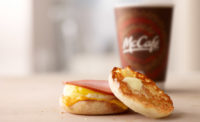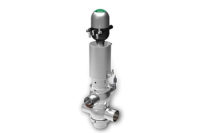
Curd is the Word
by James Dudlicek
Revamped cottage cheese operation just the latest in ongoing improvements at Safeway's Bellevue, Wash., plant.
The Pacific Northwest has
taken a beating this winter, with heavy snow and driving winds joining the
rain to which the region is accustomed. Through it all, Safeway’s
Bellevue Milk Plant just east of Seattle has continued undeterred in its
mission to supply milk and cottage cheese to the company’s
supermarkets along the West Coast as well as Alaska and Hawaii.
Over the past four years, the grocery retailing giant
has spent almost $12 million on dairy infrastructure improvements at its
Bellevue plant, most recently with a complete revamping of the cottage
cheese operation, launched in late 2005. It’s Safeway’s largest
cottage cheese plant, making 20 million pounds a year, says Randall Dei,
director of dairy supply operations. That encompasses some 70 SKUs for
Safeway’s own Lucerne brand and a variety of private label products.
“There’s not too many people doing that
now,” Dei says of such a substantial investment in a category that
doesn’t exactly breed excitement. “We took the art and made it
a science.”
The “art” of making cottage cheese once
required years of experience for an operator who had to follow his gut
almost as much as the chemistry to get a good result. A computerized system
has rendered the making of cottage cheese virtually effortless. “We
used to have direct steam injection into the vats,” Gary Gill, plant
engineer, says of the 1958-vintage equipment that was replaced.
The six new vats — the first made to
second-generation 3-A standards — are controlled from a touchscreen
that shows all stages of the cooking process, waits for the
operator’s acknowledgment of completed steps and prompts when to do
the next one, taking all the guesswork out of the process. The only manual
tasks still necessary are applying the paddles and curd-cutting blades, and
checking the pH level of the recipe. “Our consistency is very much
improved,” Gill says.
Dei explains the process after curd leaves the vats:
Hot curd is pumped through the whey drainer, then into a cooling tower
where it’s washed of excess acid whey and cooled with treated water.
Computer-controlled mixing and magnetic flowmeters ensure a correct
cream-to-curd ratio for each product; four old mixers were replaced with
two 11,000-pound units. Dressing is flowed through ice cream-type freezers
to chill it rather than the curd. Inclusions like fruit or chives are added
to the dressing before filling.
Culturing is accomplished in two 13,000-pound,
steam-sterilizable starter tanks. Carbon dioxide is injected into the
dressing as well as the three dressing tanks in adjoining room; Dei
explains that, as the dressing level goes down, CO2 stays on the surface
(because it’s heavier than air) and protects against bacteria
spoilage.
Gill says the biggest part of the project was the
complete demolition of the old cheese room. “We only had a four-week
shutdown to complete the process,” he says. “We shut down on a
Friday night, and four weeks later on a Saturday morning, we were making
cheese.” Dei adds: “We had sellable product the first
day.”
During construction in the fall of 2005, Bellevue
operators were sent for training at Safeway’s Denver plant, where
similar renovations had recently been completed. Meanwhile, new walls,
floors and ceiling went up at Bellevue, with surfaces Dei described as
being “as sanitary as a hospital,” along with stainless-steel
ductwork.
Fillers were repositioned to accommodate the new
equipment; robotic palletizing will be added to the line this year.
Milk and More
Improvements elsewhere in the plant that predate the
cottage cheese project have gone a long way toward streamlining operations.
A high-speed filler can handle 150 gallons per minute
for milk and 240 for water. “It can go through a truckload of milk in
28 minutes,” Dei says, noting that the system’s frequency drive
will automatically slow down or speed up depending on activities
downstream. “This is the fastest gallon filler currently operating in
the country.”
A statistics process control weighing system ensures
legal labeling and less “giveaway” in the form of overfilled
containers, Dei explains. Cartons are randomly pulled from line and
weighed; the electronic readout instantly displays the weight and records
it. Deviations are printed in a report sent to the lab and plant manager.
A dedicated skim tank provides skim milk to be blended
with product coming off the second HTST unit to get the correct fat level
needed for various products. The system utilizes automated skimming with
flowmeters to more accurately gauge how much cream is coming off the
separators, Gill says. Meanwhile, vitamins A and D are added to milk with a
computer-controlled device that administers doses of fortification by
weight for more accurate delivery.
Gallon bottles for milk are blow molded on site.
Fillers run faster than the blow molders, so bottle-making continues when
fillers are down; bottles are stockpiled in up to 10 trailers. Bottles are
annealed at 1,100 degrees, a process that compresses the molecules to
prevent new hot bottles from shrinking after molding and ensure consistent
size of containers. Bottles are bagged and robotically palletized; Dei says
the plant is looking to automate the debagging process.
| Bellevue Plant History |
| 1958: Built to replace an aging Seattle location |
| 1970: Cooler expansion |
| 1975: Blow molding |
| 1988: Automated palletizing |
| 1999: High-speed gallon filler and container bag on |
| 2002: Two 60,000-gallon silos added |
| 2003: 2.5-gallon water line added |
| 2005: Cottage cheese renovation |
| Coming: Stand-alone boiler room, robotic palletizing for cottage cheese line |
The Bellevue plant provides fluid milk to Safeway
supermarkets in Seattle; Portland, Ore.; Idaho and Montana, which get daily
milk deliveries.”
Cottage cheese is sent to 600 stores throughout the
Pacific Northwest, Northern California and Hawaii. And twice a week, the
plant sends product packed in shipping containers aboard freighters out of
the Port of Tacoma bound for Alaska, to serve Safeway stores as far away as
Nome.
Doing it Right
The processes at Bellevue need to mirror those at the
Denver plant for product consistency, since some markets are served by both
facilities. To that end, the Bellevue team employs the latest lab tests to
ensure quality products. For example, a laser particle analyzer is used to
make sure the size of nearly all particles is less than 2 microns so milk
won’t separate at retail. Further tests check acidity, salt, calcium
and CO2.
As for food safety, the Bellevue plant was one of six
pilot plants chosen in 1999 for a voluntary HACCP program, Dei says.
Striving for “world class” manufacturing
initiatives, worker progress is evaluated at thrice-daily visual production
meetings. “It’s a very effective tool to educate ourselves on
the issues and educate those on the floor to their goals,” says plant
manager Bill Schoenbachler.
More changes are on the way at the Bellevue plant
site, outside as well as in. The milk plant sits at one end of a 39-acre
complex that also includes a distribution center, which will soon be sold
and torn down for redevelopment. Dei explains it has been replaced by a new
55-acre distribution facility in nearby Auburn with tens of thousands of
pallet spaces — 45,000 for grocery alone — and a 3-mile order selection line.
Meanwhile, the milk plant, along with an adjacent ice
cream plant and a beverage plant across the street, will continue churning
out quality products for Safeway customers.
“This is one of our older plants,” Dei
says, “but we keep it state of the art.”
For more on how Safeway does dairy, select the April
2004 issue from the drop-down menu under the current issue at
www.dairyfield.com
SAFEWAY PLANT AT A GLANCE
Location: Bellevue, Wash.
Year opened: 1958
Size: 70,000 square feet
Employees: 100 on three shifts
Products made: Milk (regular, flavored), buttermilk, eggnog, cottage cheese, water; milk sourced from Washington’s Darigold cooperative.
Capacity: 1 million gallons weekly.
Processing: Two HTST @ 52,000 pounds per hour.
Filling: Three lines for gallon, half gallon, quart and pint; two lines for cottage cheese (8-ounce, 1-, 2-, 3-, 4- and 5-pound); one line for 2.5-gallon water. Storage: Milk — 18 tanks for raw, blended and pasteurized product; 240,000 gallons raw storage, 210,000 gallons pasteurized storage. Cooler — 25,000 square feet.
$OMN_arttitle="Curd is the word";?>
$OMN_artauthor="James Dudlicek";?>Year opened: 1958
Size: 70,000 square feet
Employees: 100 on three shifts
Products made: Milk (regular, flavored), buttermilk, eggnog, cottage cheese, water; milk sourced from Washington’s Darigold cooperative.
Capacity: 1 million gallons weekly.
Processing: Two HTST @ 52,000 pounds per hour.
Filling: Three lines for gallon, half gallon, quart and pint; two lines for cottage cheese (8-ounce, 1-, 2-, 3-, 4- and 5-pound); one line for 2.5-gallon water. Storage: Milk — 18 tanks for raw, blended and pasteurized product; 240,000 gallons raw storage, 210,000 gallons pasteurized storage. Cooler — 25,000 square feet.


